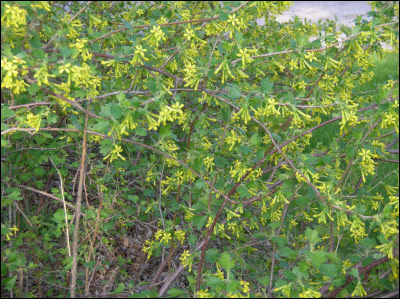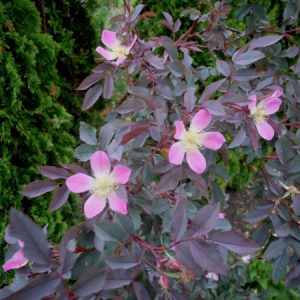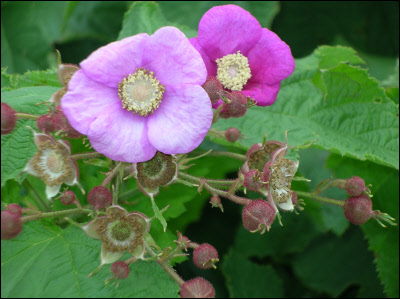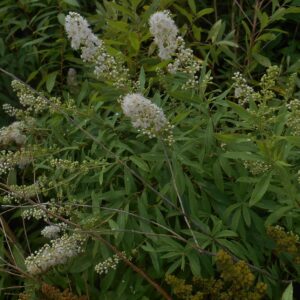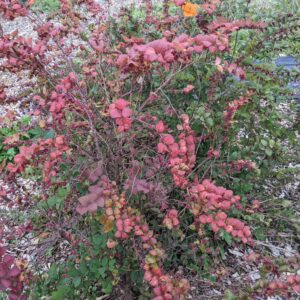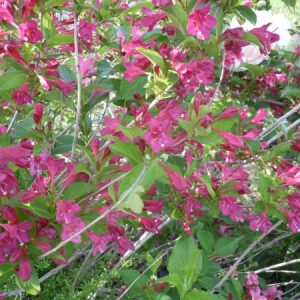Woody Ornamentals
Showing 41–48 of 48 results
-
Ribes aureum syn. Ribes odoratum Clove currant Z 3-8
yellow flowers smother the shrub
Early to mid-spring yellow flowers smother the shrub, giving off the most sweet, clove-scented fragrance – heavenly.
Size: 6' x 6'
Care: Sun in moist well-drained to well-drained soil. Immune to Walnut toxins.
Native: west-central US
Wildlife Value: attracts hummingbirds and butterflies.Found by Meriwether Lewis in 2 locations -“near the narrows of the Columbia.” April 16, 1806, now Klickitat County, Washington, and on July 29, 1805 in Montana. Many different tribes ate the berries – Blackfoot, Cheyenne, Klamath, Montana, Paiute & Ute. Others, Shoshone and Paiute, used the shrub’s inner bark to heal sores and swellings. English plantsman Wm. Robinson declared that it “deserves to be more commonly grown.” (1933)
**LISTED AS OUT OF STOCK BECAUSE WE DO NOT SHIP THIS ITEM. IT IS AVAILABLE FOR PURCHASE AT OUR RETAIL LOCATION.
-
Rosa rubrifolia syn. Rosa glauca Z 3-9
Medium pink single blooms in spring. Purplish foliage bearing red-purple hips in autumn.
OUT OF STOCK – EMAIL FOR AVAILABILITY
Medium pink single blooms in spring. Purplish foliage bearing red-purple hips in autumn.
Size: 7’ x 5’
Care: Full sun to part shade in moist well-drained soil. Disease resistant. Japanese beetles seem not to be interested in this rose.
Native: Central Europe
Awards: Plant Select; Elisabeth Carey Miller Botanical Garden Great Plant Pick & Great Plants for Great Plains; Royal Botanical Society Award of Garden MeritIn garden cultivation since 1830
**LISTED AS OUT OF STOCK BECAUSE WE DO NOT SHIP THIS ITEM. IT IS AVAILABLE FOR PURCHASE AT OUR RETAIL LOCATION.
-
Rubus odoratus Flowering raspberry Z 2-8
Purple-pink saucer shaped flowers all summer
Purple-pink saucer shaped flowers from June to October. Rarely seen shrub.
Size: 7-8' x 8' spreading
Care: Sun to shade in moist well-drained soil. Slightly acidic.
Native: Maine to Michigan, south to Illinois, Tennessee, east to North Carolina and all places in between
Wildlife Value: Immune to walnut toxins.For sale in an English catalog in 1730. William Robinson, father of the mixed perennial garden, praised the flowering raspberry as bearing “large clusters of rich purple flowers. Bearing scented leaves, the leaves and not the flowers being fragrant.”
-
Sambucus canadensis syn. Sambucus nigra var. canadensis. Elderberry, American elderberry Z 3-9
In late spring to mid-summer lavish, fragrant flat-to dome-shaped clusters of flowers bloom above this arching, multi-stemmed shrub. Late summer into fall the multitude of flowers turn into purple-black, edible fruits, up to 2000 per cluster!
In late spring to mid-summer lavish, fragrant flat-to dome-shaped clusters of flowers bloom above this arching, multi-stemmed shrub. Late summer into fall the multitude of flowers turn into purple-black, edible fruits, up to 2000 per cluster!
Size: 5-12’ x spreading quickly by suckers. Best to grow as hedge, along a roadside, fence-line or forest edge.
Care: sun to part shade in moist to well-drained soil
Native: Americas east of Rocky Mountains south to Bolivia. Wisconsin native
Wildlife Value: branches and leaves make nesting sites and give cover for birds.. Many birds (including, Pheasant, Bluebird, Cedar waxwing, Cardinal, Mockingbird and others) as well as some mammals eat the sweet, but slightly bitter, fruit. It is a source of pollen for numerous bees and other insects.Collected before 1735. Native Americans made extensive use of this, Cherokee used it topically for boils, burns and infections and internally for rheumatism, fevers, dropsy, as a diuretic, and of course ate the berries. Costanoan made its hollow twigs into pipes, flutes and shafts for arrows. Several Natives infused the flowers and foliage with hot water to make steam baths. And many natives ate it, boiled it, jammed it, and added the fruit to cakes. Today people eat them in jellies, jams, pancakes, pies and wine and make homeopathic medicine from it. Reportedly ripe berries are high in vitamin C and fiber. It’s also an antioxidant.
**LISTED AS OUT OF STOCK BECAUSE WE DO NOT SHIP THIS ITEM. IT IS AVAILABLE FOR PURCHASE AT OUR RETAIL LOCATION.
-
Spiraea alba Meadowsweet, Du Roi Z 3-7
This short shrub sports white flower spikes 4” long blooming from June to August, deadhead for rebloom.
This short shrub sports white flower spikes 4” long, blooming from June to August, deadhead for rebloom.
Size: 3-4’ x 3-4’
Care: sun to part shade in moist to moist well-drained soil
Native: Northeastern 2/3 of North America, Wisconsin native
Wildlife Value: nectar attracts butterflies & hosts caterpillars of Spring azure butterflies1st described in literature in 1772. Algonquin made a medicinal tea with Meadowsweet’s leaves and stems. Iroquois administered a decoction of mashed and powdered dry roots to remedy pain in the sides.
**LISTED AS OUT OF STOCK BECAUSE WE DO NOT SHIP THIS ITEM. IT IS AVAILABLE FOR PURCHASE AT OUR RETAIL LOCATION.
-
Symphoricarpos orbiculatus Coralberry Z 3-7
Baby-pink flowers in spring to early summer give way to clustered coral-colored berries that last through winter.
OUT OF STOCK
Baby-pink flowers in spring to early summer give way to clustered coral-colored berries that last through winter.
Size: 2’-5’ x 5-8’
Care: Part to full shade in moist well-drained to well-drained soil
Native: Eastern US from NY south to eastern TX, west to SD & CO.
Wildlife Value: pollen and nectar for small bees and butterfliesWas classified simultaneously by Michaux, Linnaeus, and finally Moench (1794) whose designation is used today.
-
Weigela florida Shrub Z 4-9
Rosy pink, white or red trumpets in May and June,repeating sporadically all summer, described by Robert Fortune as ”fine rose-coloured flowers, which hung in graceful bunches from the axils of the leaves and the ends of the branches”
Rosy pink, white or red trumpets in May and June,repeating sporadically all summer, described by Robert Fortune as ”fine rose-coloured flowers, which hung in graceful bunches from the axils of the leaves and the ends of the branches”
Size: 5’ x 4’
Care: full sun to part shade in well-drained soil. Blooms on both old and new wood so can prune anytime. Pruning promotes compact, bushy habit & more flowers.
Native: ChinaNamed for German professor Christian Ehrenfried Weigel. Introduced to western cultivation in 1845 by Robert Fortune who found it growing in a northern Chinese garden. A favorite of Queen Victoria.
**LISTED AS OUT OF STOCK BECAUSE WE DO NOT SHIP THIS ITEM. IT IS AVAILABLE FOR PURCHASE AT OUR RETAIL LOCATION.
-
Xanthorhiza simplicissima Yellowroot Z 4-9
Short, spreading shrub, blooms sprays of plum-colored flowers in spring, then forming berries. For dessert its leaves turn yellow, purple and maroon in fall. Excellent groundcover under trees and for erosion control. Will suppress weeds.
Short, spreading shrub, blooms sprays of plum-colored flowers in spring, then forming berries. For dessert its leaves turn yellow, purple and maroon in fall. Excellent groundcover under trees and for erosion control. Will suppress weeds.
Size: 2-3” x spreading
Care: filtered sun to shade in moist to moist well-drained, slightly acidic soil
Native: Maine to FL and west to Ohio
Wildlife Value: food and habitat for several birds.Colonial horticulturist William Bartram found it near Buffalo Lick GA in 1773. He wrote: “This evening I discovered a very curious Little Shrub, growing on the bottoms of these Hills & on the steep banks of the Creek. . . the root affording strong Yellow Tincture. . . It has long slender branching Roots which run & spread about . . . filling large patches of ground . . . it is in my opinion a very valuable Shrub . .”
Native Americans dyed fibers with the yellow root.

